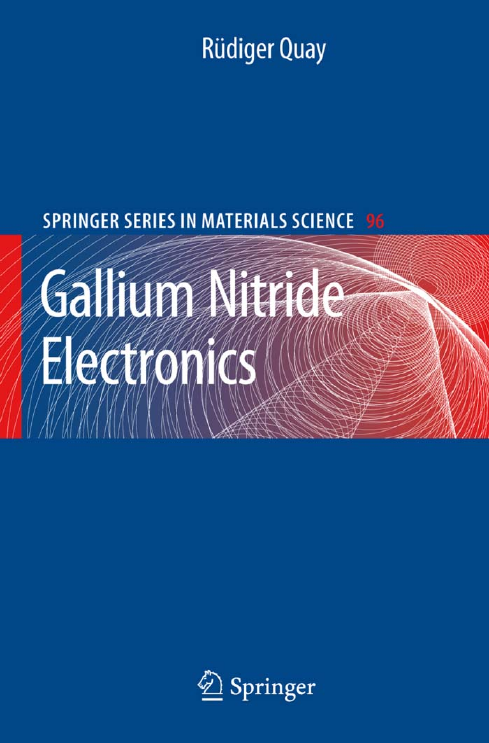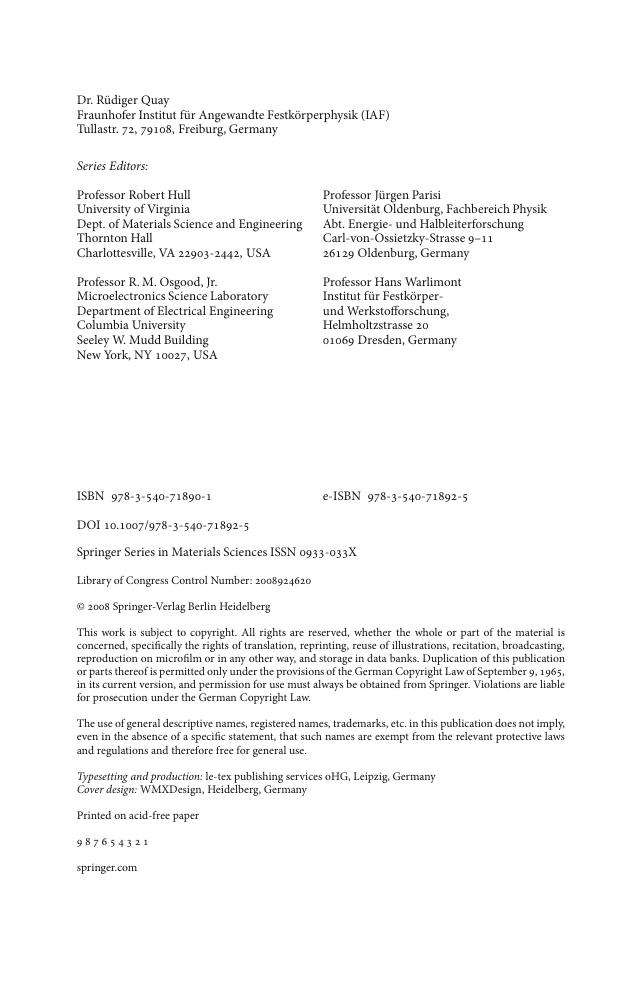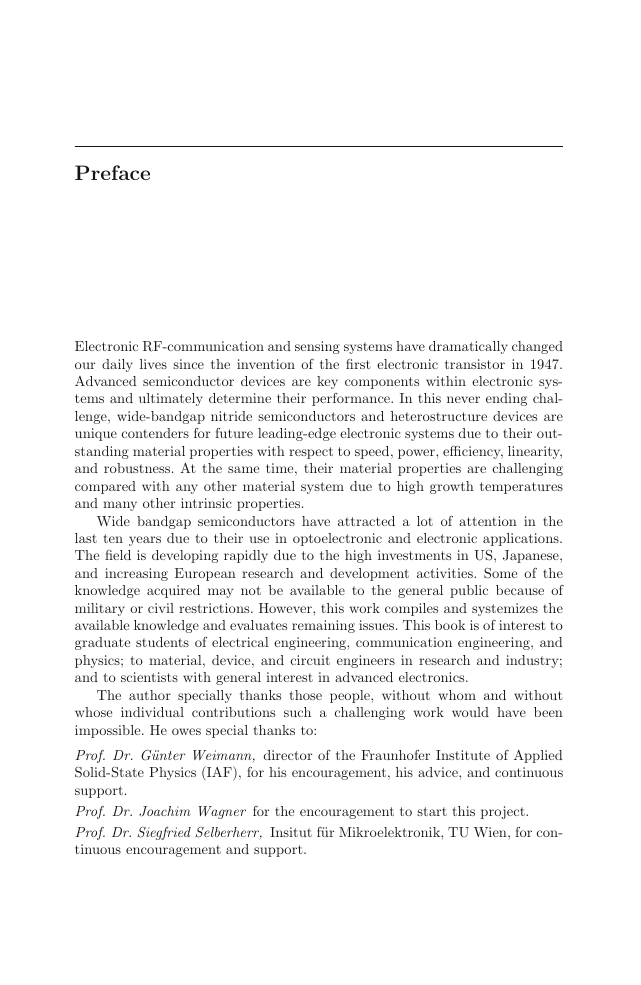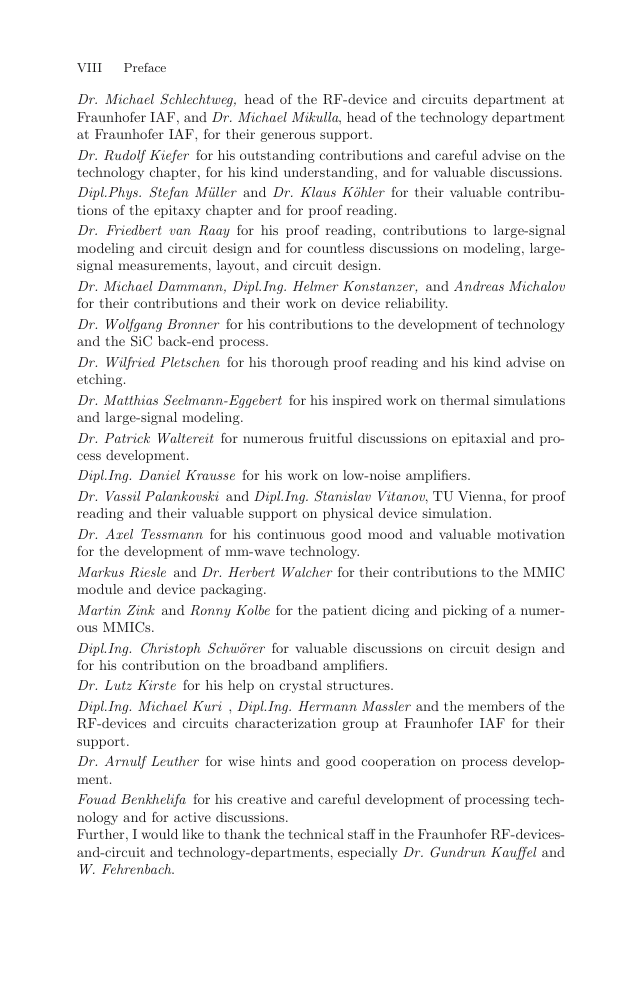Contents
List of Symbols
List of Acronyms
1. Introduction
2. III-N Materials, and the State-of-the-Art of Devices and Circuits
2.1 State-of-the-Art of Materials Research
2.1.1 Binary Materials
2.1.2 Material Limitations
2.1.3 Thermal Properties and Limitations
2.1.4 Ternary and Quaternary III-N Materials
2.2 Polar Semiconductors for Electronics
2.2.1 Spontaneous Polarization
2.2.2 Piezoelectric Polarization
2.2.3 Device Design Using Polarization-Induced Charges
2.2.4 Analytical Calculation of Channel Charge Concentrations
2.2.5 Doping Issues
2.2.6 Surfaces and Interfaces
2.2.7 Transport Properties in Polarized Semiconductors
2.2.8 Polarization-Based Devices and Their Specific Properties
2.3 Electrical and Thermal Limitations of Materials and Devices
2.3.1 Physical Modeling of Devices
2.3.2 Devices: Figures-of-Merit
2.3.3 III-N Devices: Frequency Dispersion
2.4 Substrates for Electronic Devices
2.4.1 Criteria for Substrate Choice
2.4.2 Silicon Carbide Substrates
2.4.3 Sapphire Substrates
2.4.4 Silicon Substrates
2.4.5 GaN and AlN Substrates
2.5 State-of-the-Art of Devices and Circuits
2.5.1 Nitride-Based Diodes
2.5.2 Power Electronics
2.5.3 RF-Metal Semiconductor Field-Effect Transistors (MESFETs)
2.5.4 Metal Insulator Semiconductor Field-Effect Transistors (MISFETs)
2.5.5 High-Electron Mobility Transistors (HEMTs)
2.5.6 Heterojunction Bipolar Transistors (HBTs)
2.5.7 MMIC HEMT Technology
2.6 Applications Issues
2.6.1 Broadband Communication
2.6.2 Radar Components
2.6.3 Electronics in Harsh Environments
2.7 Problems
3. Epitaxy for III-N-Based Electronic Devices
3.1 The AlGaN/GaN Material System
3.1.1 Metal Organic Chemical Vapor Deposition (MOCVD)
3.1.2 Molecular Beam Epitaxy (MBE)
3.1.3 MOCVD and MBE Growth on Alternative Substrates
3.1.4 Epitaxial Lateral Overgrowth (ELO)
3.1.5 Hydride Vapor Phase Epitaxy (HVPE)
3.2 Indium-Based Compounds and Heterostructures
3.2.1 MOCVD Growth of Indium-Based Layers
3.2.2 MBE Growth of Indium-Based Layers
3.2.3 Indium-Based Heterostructure Growth
3.3 Doping and Defects
3.3.1 MOCVD Growth
3.3.2 MBE Growth
3.4 Epitaxial Device Design
3.4.1 Geometrical Considerations
3.4.2 Growth of Cap Layers
3.4.3 Doping
3.4.4 AlN Interlayer
3.4.5 Channel Concepts
3.4.6 Epitaxial In-Situ Device Passivation
3.5 Problems
4. Device Processing Technology
4.1 Processing Issues
4.2 Device Isolation
4.2.1 Mesa Structures
4.2.2 Ion Implantation for Isolation
4.3 Contact Formation
4.3.1 Ohmic Contacts
4.3.2 Schottky Contacts
4.4 Lithography
4.4.1 Optical Lithography
4.4.2 Electron Beam Lithography
4.4.3 Field Plates and Gate Extensions
4.5 Etching and Recess Processes
4.5.1 Dry Etching
4.5.2 Wet Etching
4.5.3 Recess Processes
4.6 Surface Engineering and Device Passivation
4.6.1 Passivation of the Ungated Device Region
4.6.2 Physical Trapping Mechanisms
4.6.3 Trap Characterization
4.6.4 Technological Measures: Surface Preparation and Dielectrics
4.6.5 Epitaxial Measures: Surface Preparation and Dielectrics
4.7 Gate Dielectrics
4.8 Processing for High-Temperature Operation
4.9 Backside Processing
4.9.1 Thinning Technologies
4.9.2 Viahole Etching and Drilling Technologies
4.9.3 Viahole Metallization
4.10 Problems
5. Device Characterization and Modeling
5.1 Device Characteristics
5.1.1 Compact FET Analysis
5.1.2 Compact Bipolar Analysis
5.2 Frequency Dispersion
5.2.1 Dispersion Effects and Characterization
5.2.2 Dispersion Characterization and Analysis
5.2.3 Models for Frequency Dispersion in Devices
5.2.4 Suppression of Frequency Dispersion
5.3 Small-Signal Characterization, Analysis, and Modeling
5.3.1 RF-Characterization and Invariants
5.3.2 Common-Source HEMTs
5.3.3 Dual-Gate HEMTs
5.3.4 Pulsed-DC- and RF-Characteristics
5.3.5 Small-Signal Modeling
5.4 Large-Signal Analysis and Modeling
5.4.1 Large-Signal Characterization and Loadpull Results
5.4.2 Large-Signal Modeling
5.5 Linearity Analysis and Modeling
5.5.1 Basic Understanding
5.5.2 Nitride-Specific Linearity Analysis
5.6 Noise Analysis
5.6.1 Low-Frequency Noise
5.6.2 RF-Noise Analysis and Characterization
5.7 Problems
6. Circuit Considerations and III-N Examples
6.1 Passive Circuit Modeling
6.1.1 Coplanar-Waveguide Transmission-Line Elements
6.1.2 Microstrip-Transmission-Line Elements
6.2 High-Voltage High-Power Amplifiers
6.2.1 Basic Principles of High-Voltage High-Power Operation
6.2.2 General Design Considerations of III-N Amplifiers
6.2.3 Mobile Communication Amplifiers Between 500MHz and 6GHz
6.2.4 C-Frequency Band High-Power Amplifiers
6.2.5 X-Band High-Power Amplifiers
6.2.6 Design, Impedance Levels, and Matching Networks
6.2.7 Broadband GaN Highly Linear Amplifiers
6.2.8 GaN Mm-wave Power Amplifiers
6.3 Robust GaN Low-Noise Amplifiers
6.3.1 State-of-the-Art of GaN Low-Noise Amplifiers
6.3.2 Examples of GaN MMIC LNAs
6.4 Oscillators, Mixers, and Attenuators
6.4.1 Oscillators
6.4.2 GaN HEMT Mixer Circuits
6.4.3 Attenuators and Switches
6.5 Problems
7. Reliability Aspects and High-Temperature Operation
7.1 An Overview of Device Testing and of Failure Mechanisms
7.1.1 Description of Device Degradation
7.1.2 Degradation Mechanisms in III-N FETs
7.1.3 III-V HBT Device Degradation
7.2 Analysis of Nitride-Specific Degradation Mechanisms
7.2.1 DC-Degradation
7.2.2 RF-Degradation
7.3 Failure Analysis
7.3.1 Failure Mechanisms
7.3.2 Reliability Case Studies
7.4 Radiation Effects
7.5 High-Temperature Operation
7.6 Problems
8. Integration, Thermal Management, and Packaging
8.1 Passive MMIC Technologies
8.1.1 Passive Element Technologies
8.1.2 Microstrip Backend Technology
8.2 Integration Issues
8.3 Thermal Management
8.3.1 Thermal Analysis
8.3.2 Thermal Material Selection and Modeling
8.3.3 Basic Thermal Findings, Heat Sources, and Thermal Resistances
8.3.4 Backside Cooling
8.3.5 Flip-Chip Integration
8.3.6 Dynamic Thermal Effects
8.4 Device and MMIC Packaging
8.4.1 Dicing
8.4.2 Die-Attach
8.4.3 Package Technology Selection
8.4.4 Thermal Management for Linear Applications
8.4.5 Active Cooling
8.5 Problems
9. Outlook
Appendix
References of Chapter 2
References of Chapter 3
References of Chapter 4
References of Chapter 5
References of Chapter 6
References of Chapter 7
References of Chapter 8
Index
A
B
C
D
E
F
G
H
I
K
L
M
N
O
P
Q
R
S
T
U
V
W
X
Z
















 2023年江西萍乡中考道德与法治真题及答案.doc
2023年江西萍乡中考道德与法治真题及答案.doc 2012年重庆南川中考生物真题及答案.doc
2012年重庆南川中考生物真题及答案.doc 2013年江西师范大学地理学综合及文艺理论基础考研真题.doc
2013年江西师范大学地理学综合及文艺理论基础考研真题.doc 2020年四川甘孜小升初语文真题及答案I卷.doc
2020年四川甘孜小升初语文真题及答案I卷.doc 2020年注册岩土工程师专业基础考试真题及答案.doc
2020年注册岩土工程师专业基础考试真题及答案.doc 2023-2024学年福建省厦门市九年级上学期数学月考试题及答案.doc
2023-2024学年福建省厦门市九年级上学期数学月考试题及答案.doc 2021-2022学年辽宁省沈阳市大东区九年级上学期语文期末试题及答案.doc
2021-2022学年辽宁省沈阳市大东区九年级上学期语文期末试题及答案.doc 2022-2023学年北京东城区初三第一学期物理期末试卷及答案.doc
2022-2023学年北京东城区初三第一学期物理期末试卷及答案.doc 2018上半年江西教师资格初中地理学科知识与教学能力真题及答案.doc
2018上半年江西教师资格初中地理学科知识与教学能力真题及答案.doc 2012年河北国家公务员申论考试真题及答案-省级.doc
2012年河北国家公务员申论考试真题及答案-省级.doc 2020-2021学年江苏省扬州市江都区邵樊片九年级上学期数学第一次质量检测试题及答案.doc
2020-2021学年江苏省扬州市江都区邵樊片九年级上学期数学第一次质量检测试题及答案.doc 2022下半年黑龙江教师资格证中学综合素质真题及答案.doc
2022下半年黑龙江教师资格证中学综合素质真题及答案.doc